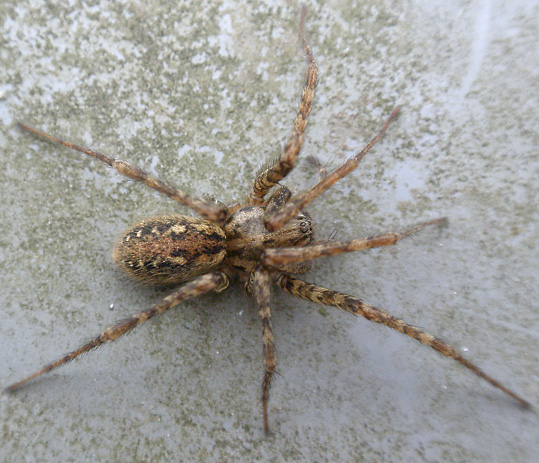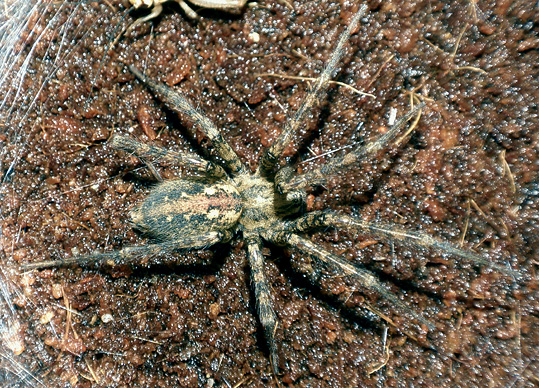
Home > Phylum selection > Arthropoda > Araneae > Agelenidae
Home How to cite this site Terms & conditions Disclaimer Contact Site tutorial / Help Links |
Tegenaria ferruginea Rostrote Winkelspinne |
 Female. Specimen photographed in Göttingen (Niedersachsen) on September 5, 2012.  Specimen photographed in Göttingen (Niedersachsen) on June 25, 2010. Subspecies Original description Synonyms Aranea ferruginea Panzer, 1804 Tegenaria
ferruginea (Panzer, 1804)
Malthonica ferruginea
(Panzer, 1804)
Aranea subpilosa
Panzer, 1804Aranea stabularia C. L. Koch, 1834 Tegenaria
stabularia (C. L. Koch,
1834)
Tegenaria
petrensis C. L. Koch, 1840 Tegenaria
domestica petrensis (C. L. Koch,
1840)
Araneus domesticus
auct. nec Clerck, 1757 (misidentification)Aranea domestica auct. nec Clerck, 1757 (misidentification) Tegenaria domestica auct. nec Clerck, 1757 (misidentification) Philoeca domestica auct. nec Clerck, 1757 (misidentification) Tegenaria guyoni auct. nec Guérin, 1837 (misidentification, misspelling) Note: this species is morphologically very similar to Tegenaria parietina and it is very difficult to separate both species by external characters. Therefore, they have been considered as closely related or sister taxa for a long time. It is, therefore, hardly surprising that the recent placement of both species in separate genera was received with scepticism: Tegenaria ferruginea is placed in Malthonica by most authors, whereas Tegenaria parietina is retained in Tegenaria. To explain the similarities between the two species despite their placement in separate genera it is argued that the similarities between the species evolved by convergence. However, the phylogenetic analysis by Bolzern et al. 2010 clearly shows that Malthonica and Tegenaria are not monophyletic if both are recognized as separate taxa. And what is even more intriguing: "Malthonica" ferruginea and its "lost" sister Tegenaria parietina come out as a monophyletic clade in the tree of Bolzern et al. 2010. This shows that they are indeed two very closely related species and do not belong to separate genera. To me this is clear evidence that Malthonica and Tegenaria are not separate genera. I therefore reject the validity of Malthonica and consider it as a junior synonym of Tegenaria. Identification A large spider. Females range between 11-14 mm, males are smaller, between 9-11 mm. The opisthosoma shows a beautiful pattern of yellow and red marks on a dark background. The pattern is very specific and together with the banded legs can be used for jizz identification. Very similar species are Tegenaria silvestris and Tegenaria parietina. Tegenaria silvestris is much smaller and more light colored and the contrast of the black pattern against the light ground color of the prosoma is much clearer than in Tegenaria ferruginea. Tegenaria parietina is usually slightly larger than Tegenaria ferruginea and the prosoma usually appears uniformly brownish. In addition, the legs appear less banded. Distribution Recorded from most of Europe, but absent from Britain. Biology Adult males are usually present in the summer only (from May-September), whereas females can be found all year. The species belongs to the synanthropic members of the Agelenidae and can be found in cellars, attics or other dark and sheltered spaces in buildings. Its natural habitat are interstices within rock, below stones and tree bark. A common species in Germany. The cocoon produced by the female is reported in the literature to be very flat and the female is said to stick it to the ceiling of its shelter. In the cases that I have observed, however, the cocoon was ovoid and the cocoon was suspended in a cradle made from tough white silk. After a few days this suspension web and the cocoon are camouflaged with dirt and other debris and the female guards the cocoon sitting within the cradle on top of the cocoon. This page has been updated on December 17, 2012 This site is online since May 31, 2005 Copyright © by Nikola-Michael Prpic. All rights reserved. |
< Previous | Next > Subspecies Original description Synonyms Identification Distribution Biology References  |